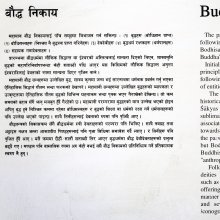Vyapakata, Vyapaka-ta, Vyāpakatā: 4 definitions
Introduction:
Vyapakata means something in Hinduism, Sanskrit. If you want to know the exact meaning, history, etymology or English translation of this term then check out the descriptions on this page. Add your comment or reference to a book if you want to contribute to this summary article.
Images (photo gallery)
In Hinduism
Shaivism (Shaiva philosophy)
Source: SOAS University of London: Protective Rites in the Netra TantraVyāpakatā (व्यापकता) refers to the “pervader” (i.e., that which permeates the others), according to the Netratantroddyota commentary on the Netratantra of Kṣemarāja: a Śaiva text from the 9th century in which Śiva (Bhairava) teaches Pārvatī topics such as metaphysics, cosmology, and soteriology.—Accordingly, [verse 4.3cd-4ab]—“[...] This means, he should contemplate each of these paths [that has to be purified]. After [he] makes it the principle [path of worship he becomes the] pervader (vyāpakatā), [i.e., that which permeates the others] with the form of [potential or manifest] explicitness in the remaining five paths. Included within [the path], as it has spread, is the form of potential. As has been said in the Svacchanda-tantra, ‘[he should] visualize the adhvans as pervaded by [the others and the others] pervaded by it’”.

Shaiva (शैव, śaiva) or Shaivism (śaivism) represents a tradition of Hinduism worshiping Shiva as the supreme being. Closely related to Shaktism, Shaiva literature includes a range of scriptures, including Tantras, while the root of this tradition may be traced back to the ancient Vedas.
Languages of India and abroad
Sanskrit dictionary
Source: Cologne Digital Sanskrit Dictionaries: Monier-Williams Sanskrit-English DictionaryVyāpakatā (व्यापकता):—[=vy-āpaka-tā] [from vy-āpaka > vy-āp] f. pervasion, diffusion, comprehensiveness, invariable concomitance or inherence (in logic), [Bhāgavata-purāṇa; Bhāṣāpariccheda] etc.
Source: Cologne Digital Sanskrit Dictionaries: Yates Sanskrit-English DictionaryVyāpakatā (व्यापकता):—(tā) 1. f. Diffusion, inherence; universality of presence; gaining. Commonly vyāpti.
Sanskrit, also spelled संस्कृतम् (saṃskṛtam), is an ancient language of India commonly seen as the grandmother of the Indo-European language family (even English!). Closely allied with Prakrit and Pali, Sanskrit is more exhaustive in both grammar and terms and has the most extensive collection of literature in the world, greatly surpassing its sister-languages Greek and Latin.
Nepali dictionary
Source: unoes: Nepali-English DictionaryVyāpakatā (व्यापकता):—n. → व्यापक [vyāpaka]
Nepali is the primary language of the Nepalese people counting almost 20 million native speakers. The country of Nepal is situated in the Himalaya mountain range to the north of India.
See also (Relevant definitions)
Starts with: Vyapakatavadartha.
Query error!
Full-text: Vyapakatavadartha, Avyapakata, Vyapaktaa, Vyapitva, Sadhyavyapakata, Vyapti, Vyapakatva, Sharva, Sharv.
Relevant text
Search found 4 books and stories containing Vyapakata, Vyapaka-ta, Vyāpaka-tā, Vyāpakatā; (plurals include: Vyapakatas, tas, tās, Vyāpakatās). You can also click to the full overview containing English textual excerpts. Below are direct links for the most relevant articles:
Brihad Bhagavatamrita (commentary) (by Śrī Śrīmad Bhaktivedānta Nārāyana Gosvāmī Mahārāja)
Verse 2.2.198 < [Chapter 2 - Jñāna (knowledge)]
Notices of Sanskrit Manuscripts (by Rajendralala Mitra)
Page 192 < [Volume 5 (1879)]
Nyaya-Vaisheshika categories (Study) (by Diptimani Goswami)
Vṛttyaniyāmaka-sambandha (Non-Occurrent-Exacting Relation) < [Chapter 6 - Nyāya-Vaiśeṣika theory of Relation]
The concept of Sharira as Prameya (by Elizabeth T. Jones)
Indriyas (Sense organs) < [Chapter 3]
Related products

